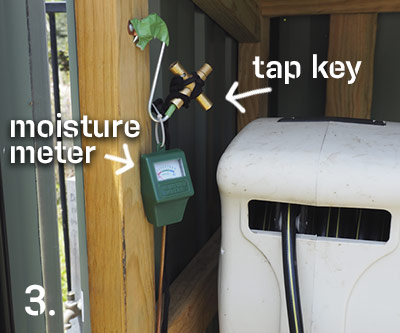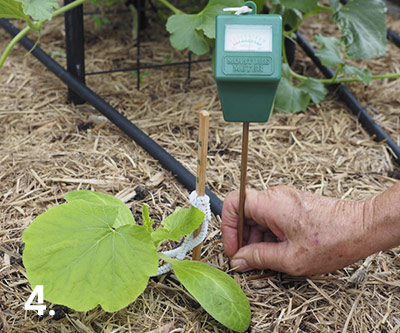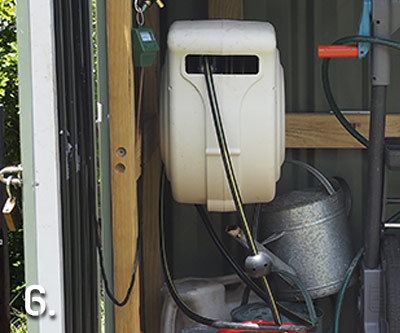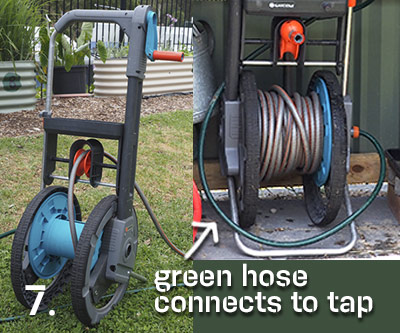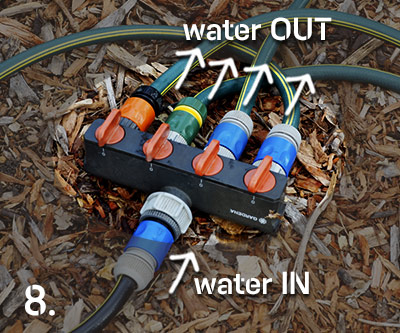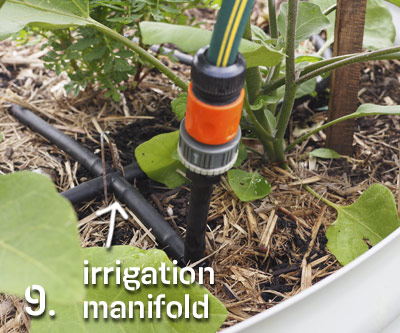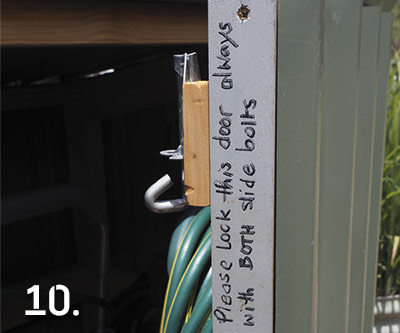Water is essential for plants to grow and stay healthy. Without the necessary amount of water, plants cannot take up nutrients, they wilt and they are more prone to get diseases.
- Watering needs to happen on a regular basis
- Watering should keep the soil moist, but not wet
- Water the soil not the leaves, leaves should be kept dry, to avoid fungi like mildew to thrive
- Keeping the soil well mulched helps to reduce evaporation
Everything our members need to water our garden is located in the tap shed at the fence.
Depending on the conditions, watering can take some time. Whatever time you have, just water the beds (such as seedlings) that need it most and leave a note in the watering diary in the tap shed, of what you have done.
1. The tap shed is next to the water tap at the fence
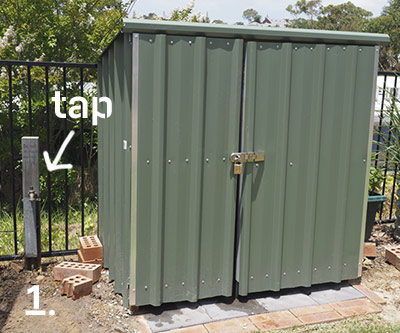
Members can open the lock to get into the shed.
2. Plenty of options to water the garden

In the shed are several options available which can be used to water the garden.
- Watering cans
- The retractable hose
- The hose trolley
- Some spare hoses
- The octopus
- A variety of nozzles
3. Moisture meter and tap key
The moisture meter and the key for the tap are located at the left upper corner of the shed.
4. Using the moisture meter
To make sure that we know which beds need watering we use a moisture meter. If the spike of the meter is poked into the soil, the dial instantly indicates how moist the soil is. Beds that show ‘dry’ or close to ‘dry’ need watering.
- Always test two or three spots per bed, it might be moist at one end and dry at the other
- The meter only gives a picture of the situation at it’s tip. Poke it in as deep as you expect the roots to be to get an exact result. In a bed with seedlings just put it in 2 cm deep, because the roots are still tiny, in a bed with established plants poke it in 10 cm deep.
- Wipe the spike clean after use, so it doesn’t corrode and put it back into the shed
5. Getting it all connected
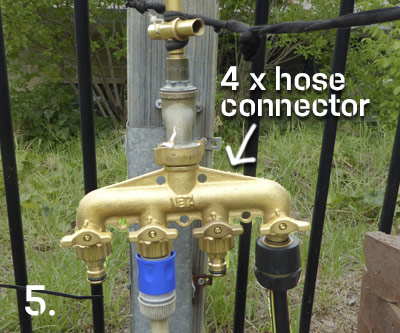
- If the brass quadruple hose connector divides the water into up to 4 outlets. Each outlet has a valve to regulate it’s water flow.
- Every hose has connectors attached to it, some are orange, some blue and the one on the retractable hose is black, but they all operate the same way:
- They are pushed onto the outlet until it clicks to fit them ( if they are hard to push on, pulling back the sleeve while doing this helps)
- The coloured (or black) sleeve is pulled back to open and remove them
- It’s good practice to place a bucket under the tap, because there is always some water running off, that can be saved.
- Use the tap key to fully open the tap, use the valves to regulate the water flow.
6. The retractable hose
- The retractable hose has a short black piece of hose which needs to be connected to the tap.
- The working end of the retractable hose is the one with the ball attached to it. If you pull the hose out, the mechanism tries to pull it back. Pull as much out as need and then slowly release it, it will lock in place.
- To retract the hose, it’s best to hold it in your hands standing next to the shed. Pull a bit more hose out of the mechanism and then slowly let the mechanism retract the hose. Keep the hose in your hand to allow it to retract in a controlled way.
7. The trolley
- Take the trolley out of the shed.
- The short green hose of the trolley connects it from the centre of the wheel to the tap.
- Pull out as much hose as you need.
- Turn the crank to wind the hose up again.
8. The octopus
To water more than one bed at the same time you can use the octopus, it divides the water into four outlets.
- Connect the working end of a hose (spare hose, retractable hose, hose on a trolley) to the inlet.
- Connect the four outlets to the manifolds in the garden beds you want to water.
- You can regulate the water flow of each single outlet by using the valves.
9. Irrigation manifolds
All the garden beds are equipped with irrigation manifolds. The irrigation manifolds at the fence beds are grouped together into clusters, watering several beds in one go.
- Connect the hose to the manifold.
- Start watering and adjust the flow so sufficient water is coming through.
- Also make sure that the water is not spurting all over the place. Put a handful of sugar cane mulch over the part that is squirting.
10. Close the tab shed
- Put everything back into the tab shed.
- Bolt the two slide bolts on the right door back into place
- Close the shed and scramble the lock.
